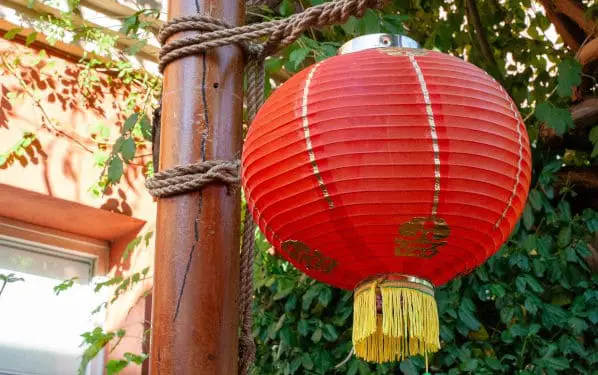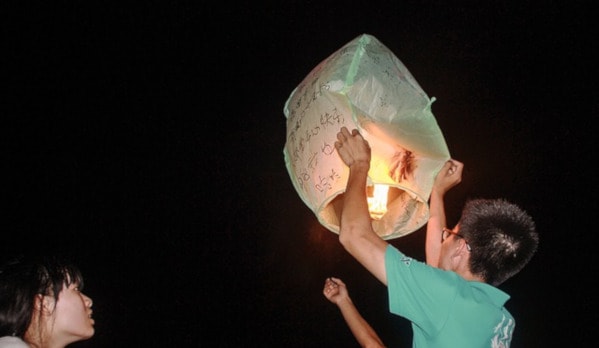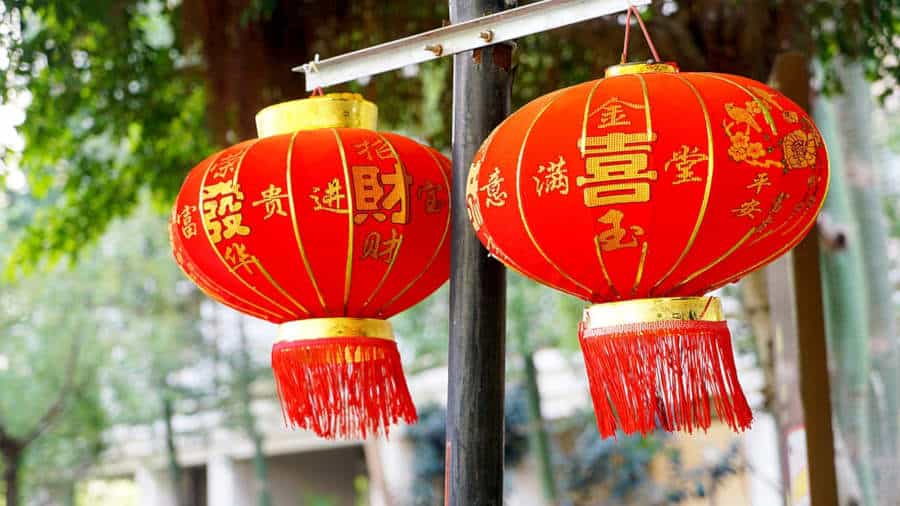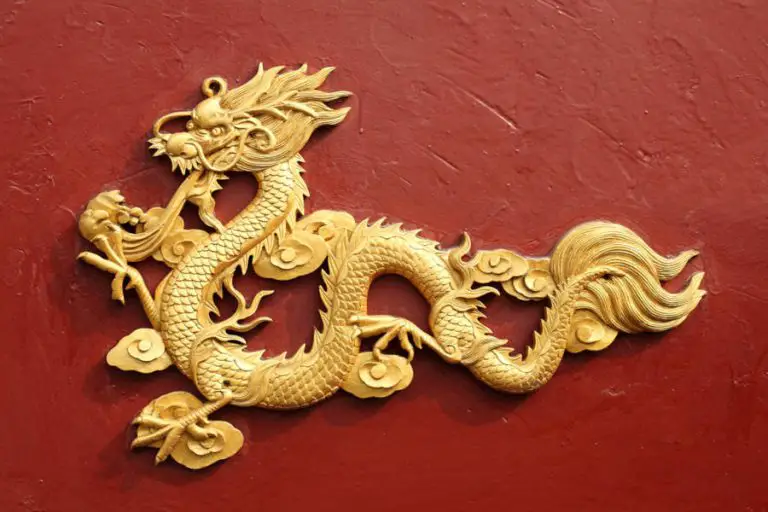The traditional Chinese lantern is probably one of the most renowned symbols of Chinese culture all around the world.
Many Chinese restaurants or Chinese-themed buildings featured Chinese traditional lantern at their entrance, even outside China. Thus, even foreigners can easily associate the bright-red, paper lantern with the Chinese Identity.
For the Chinese and Chinese-descent, however, the red traditional lanterns will always remind them of the Chinese New Year, and especially the Chinese lantern festival—celebrated 15 days after the Chinese New Year—.
Oval-shaped, made of paper, and colored bright red with gold decorations, the Chinese traditional lantern might have a different meaning for different people, but the history behind it is still well preserved with its clear beginning.
Chinese Lanterns: History and Meaning
It is well believed that Chinese paper lanterns originated from the times of the Eastern Han Dynasty, reigning during 25-220 CE ( ancient.eu).
The emergence of these paper lanterns, unsurprisingly, coincides with the invention of paper—or more accurately, paper making— another Chinese invention.
Thus, the actual origin of the Chinese traditional lantern is purely functional: people are looking for a better light source, and they found out that by surrounding a candle with paper (or silk and animal skin, back then) can protect the candle flame from the wind. Thus, back then, the paper used isn’t always colored red.
People then started decorating the lantern covers with Chinese characters, pictures, and different colors, mainly as a way to advertise the direction to a shop, or even as signage for an establishment. This is where the practice of coloring and decorating Chinese lanterns originated.
Soon after that, the paper lanterns are incorporated into Buddhism religious practices.
It is said that emperor Ming of Han ( ChinaKnowledge.de – An Encyclopaedia on Chinese History )—also known as Liu Zhuang (劉莊) or Han Mingdi Liu Zhuang 漢帝劉莊 (58-75CE) —, saw how Buddhist monks lit the paper lanterns in the temples on the fifteenth day after the new year.
A devout Buddhist himself, he ordered the citizens and the palace inhabitants to light the Chinese lanterns to worship the Buddha—just as the monks did—. Gradually, this practice became the custom, and later on, flourished as the grand traditional festival we know as the Spring Lantern Festival (more on this further below).

During the relatively peaceful Tang Dynasty (618-907 CE) ( ancient.eu ) —often known as the zenith, the most prosperous time of Ancient China—, the citizens made paper lanterns as decorations and ritual symbols to celebrate their prosperous, peaceful lives. This is the time when the bright red color was popularized as the main color of Chinese lanterns.
Red—representing fire—was and still is the national color of China, representing prosperity, happiness, and good fortune. The traditional Chinese lanterns are partly responsible for spreading the popularity of the bright red color as the national identity of China all around the world.
Nevertheless, the function and meaning of Chinese lanterns have shifted over time. It originated simply as a light source, but as more efficient and practical light sources were developed over the years, now the Chinese lanterns are mainly used for decorations, ritualistic, and festivities purposes.
Check out our “Free Culture Library“. We have compiled some great free resources, about Chinese culture, for your research.
The History of Chinese Lantern Festival
There are several beliefs surrounding the origin of the Lantern Festival or the Spring Lantern Festival, the most popular one is linked to the Emperor Ming of Han, which we have discussed above.
Another popular legend tells the tale of 玉帝 Yù Dì (the Jade Emperor), one of the most important gods of Chinese Taoism. It is said that the Jade Emperor was really angry at a town because his favorite crane was killed by the townfolks. Thus, he planned to burn the town with fire.
A fairy, however, advised the townfolks to light red lanterns across the town, fooling the Jade Emperor with all the lights, thinking that the town was already engulfed in flames. The tradition of carrying bright red lanterns was commemorated annually as a symbol of gratitude.
Yet another popular myth surrounding the origin of the Lantern Festival involves Dongfang Shuo—the emperor’s adviser— and a maid named Yuan-Xiao. Dongfang Shuo once rescued Yuan-Xiao when she was just about to commit suicide because she wanted to meet her family.
Shuo then promised to help her and set up a fortune-telling stall on the street. Due to Shuo’s popularity, the stall went really busy, but Shuo used this opportunity to set up a rumor: a calamitous fire on the fifteenth day after the new year.
With the rumor spreading quickly, Shuo spreads another rumor that on the thirteenth day, a fairy dressed in red will show up, and when people saw this fairy they should ask for mercy. Yuan-Xiao is the one pretending to be the red fairy, and she pretended that she had a copy of a decree from the God of Fire that the capital city would burn down on the fifteenth.
Fearing the God of Fire, the emperor ordered every house to prepare tangyuan (sweet dumplings) and hang red lanterns to worship the God of Fire. Yuan-Xiao’s parents then went to the city to watch the lantern decoration, and reunite with their daughters. This is why the day is also often called the Yuan-Xiao festival, and the practice of eating tangyuan during the Lantern Festival is still kept until this day.
Related reading: “9 Major Chinese Festivals that You Need to Know” – Opens in a new tab

Symbolism in Chinese Lanterns
Chinese lanterns are imbued with rich symbolism that extends far beyond their decorative function. Their meanings are shaped by color, shape, context, and the customs surrounding their use, reflecting deep-rooted beliefs and aspirations in Chinese culture.
Color Symbolism
- Red Lanterns: Red is the most prevalent color for Chinese lanterns, symbolizing good luck, happiness, prosperity, and vitality. During festivals like the Chinese New Year and the Lantern Festival, red lanterns are hung to invite good fortune and ward off evil spirits.
- Yellow Lanterns: Yellow is associated with good luck, neutrality, and imperial authority, as it was the exclusive color of emperors in ancient China. In Buddhism, yellow represents freedom from worldly concerns. Yellow lanterns are often used to wish students success in exams and to invoke blessings.
- Green Lanterns: Green symbolizes health, growth, fertility, harmony, and prosperity. Green lanterns are displayed to attract these qualities, especially during the Spring Festival.
- White Lanterns: White represents purity but is primarily used in funerary contexts, symbolizing grief and mourning.
- Blue Lanterns: Less common, blue lanterns may indicate that a family member is ill, reflecting concern and hope for recovery.
Shape and Motif Symbolism
- Round Lanterns: The traditional round shape symbolizes unity, completeness, and family togetherness. These are especially prominent during festivals celebrating reunion, such as the Mid-Autumn Festival and Lantern Festival3.
- Dragon Lanterns: Dragon-shaped lanterns represent power, strength, and good fortune. Dragons are revered in Chinese mythology and their imagery is used to invoke auspiciousness, especially during parades and major celebrations.
- Fish Lanterns: Fish are homophonous with “surplus” (鱼 yú and 余 yú), making fish lanterns a symbol of abundance, wealth, and prosperity. They are common during the New Year to express wishes for a bountiful year ahead.
- Lotus Lanterns: The lotus flower stands for purity, spiritual enlightenment, and beauty. Lotus lanterns are often used in religious ceremonies and symbolize rising above adversity.
- Palace Lanterns: These ornate lanterns, often seen in Beijing, are associated with luxury, tradition, and imperial culture, reflecting status and heritage.
Contextual Symbolism and Customs
- Festivity and Joy: Lanterns are central to major Chinese festivals, serving as symbols of celebration, joy, and communal harmony.
- Reunion and Family: Lanterns, especially during the Lantern Festival, express hopes for family reunion and togetherness, connecting generations and fostering community bonds.
- Spiritual and Religious Significance: Lanterns were historically lit by Buddhist monks as acts of devotion and worship. Floating lanterns are sometimes used to guide ancestral spirits home or to express prayers and good wishes.
- Social Status and Vitality: In ancient times, the size, complexity, and materials of lanterns could reflect the social status and vitality of the household displaying them.

Types of Chinese lanterns
Chinese lanterns can come in many different forms, designs, and colors, and we can generally divide them into several different categories:
Hanging Lanterns
Pretty self-explanatory, and also the most common type. These decorative traditional lanterns are hung from street lights, posts, or other places.
Typically lanterns are hung up from the eve of the Chinese New Year (signaling the start of the Spring Festival) and are only removed after the Spring Lantern Festival.
Sky or Flying Lanterns
This type of lantern uses a flaming source to produce hot air, allowing it to be airborne. The practice of releasing the lanterns to fly is common especially during the Mid-Autumn Festival and is very beautiful to watch. We will discuss more on sky lanterns further below.
Floating Lanterns
These lanterns are designed to float on water and are popular during Dragon Boat Festivals, or as common decorations in areas near lakes, ponds, and rivers. Floating lanterns can come in many different shapes, but most commonly they are shaped and colored like lotus flower of peach fruit.
Take a look at these awesome Chinese Lanterns.- Aff.link
More About Sky Lanterns
It is important to differentiate between the traditional Chinese lanterns with the sky lanterns, although they might incorporate similar designs and color schemes. A sky lantern—or flying lantern— is a subtype of the Chinese lanterns, but not all Chinese lanterns can fly.
The main difference is, as the name suggests, that sky lantern can “fly”.
Technically, a sky lantern is a miniature hot-air balloon, which incorporates an opening at its bottom, usually around 10 to 30 centimeters wide, and is surrounded by a stiff mesh/collar to hold the flame source. The name “sky lantern” is a direct translation of its Chinese name 天燈; pinyin: tiāndēng.
It is well believed that the primitive sky lanterns were first utilized in 3rd century BC in China for military usage— to signal between the troops—, by the legendary strategist Zhuge Liang. Zhuge Liang is also popular with the nickname KongMing, and this is where the name “KongMing lantern” comes from.
Another legend said that the name KongMing lanterns originated from the fact that they look similar to the hat which Zhuge Liang is often represented in paintings.

Why Chinese Release Lanterns To Fly?
The practice of releasing sky lanterns to fly is common during the Lantern Festival, but it is especially practiced during the Mid-Autumn Festival (中秋節), which is celebrated every 15th day of the 8th month of the lunar calendar.
People release sky lanterns because they believe it will bring them good luck, with the main philosophy that they are releasing their problems, bad luck, and worries as they set the lanterns flying.
The tradition to release sky lanterns during festivals are not only popular in China, but also throughout Asia. In Japan, for example, there is a similar festival called Toro Nagashi. In Taiwan, more specifically in the village of PingXi (cnn.com), there’s also a traditional sky lantern festival.
A Chinese sky lantern is commonly made from oiled rice paper and bamboo frame, with a small candle—or recently, flammable wax— as the flaming source of hot air.
Legal Status and Dangers of Sky Lanterns
Sky lanterns achieved flight due to its alight flame to generate hot-air, and it may land when the flame is not fully extinguished. When, for example, the sky lantern is tilted (due to wind pressure or impact), the paper material might also catch fire in flight. In this case, the flame source may remain alight when it hits the ground.
This phenomenon can cause various fire hazards, while the wireframe material can also endanger animals that might swallow it by accident.
In 2013, for example, a Chinese sky lantern caused the “largest-ever blaze” in West Midlands, UK (bbc.com), when a Chinese lantern landed on top of 100,000 tons of plastic recycling substances.
As a result of these concerns, sky lanterns are banned in some locations, including in Sanya, China, where sky lanterns are banned because they might pose a danger to aircraft and airspace navigation. The state of Washington has also banned sky lanterns statewide.

Lantern-Making: A Dying Craft and Revival
The traditional craft of lantern-making has been under threat from mass production and urbanization. However, efforts to revive it have gained momentum:
- Intangible Cultural Heritage Recognition: In 2006, the art of Chinese lantern-making was officially listed as part of China’s national intangible cultural heritage, prompting local governments to sponsor workshops, apprenticeships, and community festivals to pass down the skills.
- Sustainable Lantern Initiatives: Recent movements have emerged to create eco-friendly lanterns using biodegradable materials and LED lights instead of open flames. This fusion of tradition and modern sustainability is gaining popularity, especially among younger generations and diaspora communities.
Lantern Festivals Outside Mainland China
Chinese lantern festivals have also become prominent in other countries with significant Chinese communities:
- Malaysia and Singapore: The Mid-Autumn and Lantern Festivals are widely celebrated with lantern processions in schools, temples, and community centers. These regions also see multi-ethnic participation, reflecting Southeast Asia’s multicultural fabric.
- United States and Canada: Major cities like San Francisco, Vancouver, and Toronto host elaborate lantern festivals in Chinatown districts or botanical gardens. These often feature multicultural themes, combining Chinese elements with local arts and performance styles.
Take a look at these awesome Chinese Lanterns.- Aff.link
Final Thoughts
In many, if not most cities in China, people light their bright colored lanterns every year during the Mid-Autumn Festival, Chinese New Year, the annual Harbin’s Ice and Snow Festival, and obviously the Spring Lantern Festival.
The Lantern Festival remains the best time to experience and view Chinese lanterns, normally between February 5th and March 7th.
Related reading: “Hongbao – The Chinese Red Envelopes“
Stay in Touch
 Join our newsletter by using the forms on this website or click here!
Join our newsletter by using the forms on this website or click here! Follow us on Google News
Follow us on Google News Follow us on Facebook
Follow us on Facebook
Featured Image by Silentpilot from Pixabay





